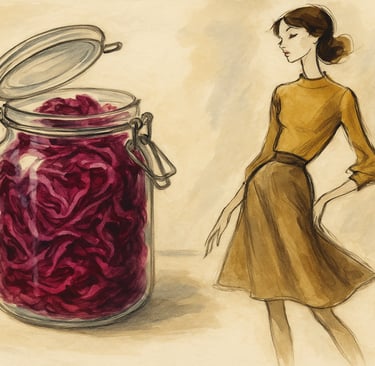Beginner’s Fermented Red Cabbage (Sauerkraut-Style)
Beginner-friendly fermented red cabbage recipe — simple, probiotic-rich sauerkraut made with just cabbage, salt, and time. Great for gut health and winter meals.
RECEPIESFERMENTATION


Type: Lacto-fermentation
Prep Time: 15 minutes
Fermentation Time: 5–14 days
Skill Level: Beginner
Good For: Gut health, winter salads, sandwiches, ancestral rituals
Ingredients
1 medium red cabbage (about 800g–1kg)
1 tablespoon sea salt (non-iodised)
Optional extras (for flavour or tradition):
1 grated carrot (adds sweetness and crunch)
1 tsp caraway seeds (classic German flavour)
A few slices of apple (used in Romania for aroma)
A clove of garlic, finely sliced
A few peppercorns
Equipment
1 large glass jar or ceramic crock (1–1.5 litres)
Large bowl
Something to pound with (a clean rolling pin, wooden spoon, or fist)
A weight (fermenting stone or ziplock bag with water)
Cloth or loose lid
Method
Shred the Cabbage
Remove outer leaves (save one for later).
Cut cabbage into quarters, remove the core, and shred finely.
Salt and Massage
Place shredded cabbage in a large bowl. Sprinkle with salt.
Massage the salt into the cabbage with your hands — it’ll begin to release water. Keep squeezing for 5–10 minutes until very juicy.
Pack the Jar
Tightly press the cabbage into the jar a handful at a time. Pack it down so the brine rises over the cabbage.
Pour in any leftover juice from the bowl.
Leave about 2–3 cm of space at the top.
Weigh It Down
Place a folded outer cabbage leaf on top to hold shreds down. Add a weight to keep it submerged.
Cover with a cloth or loose lid.
Ferment
Leave the jar at room temperature, out of direct sunlight.
After 2–3 days, it should begin to bubble. Press down daily to keep submerged.
Fermentation Timeline
Day 3–5: Begins to fizz, smell slightly sour.
Day 7–10: Developing full tangy flavour — taste daily.
Day 10–14: Ready!
Once you love the flavour, refrigerate to slow fermentation. It lasts for months.
Tips for Beginners
Always press the cabbage under brine — this prevents mould.
If white scum (kahm yeast) appears, skim it off. It's harmless.
Use red or green cabbage — red gives a beautiful colour and deeper flavour.
Don’t add too many extras on your first go — keep it simple!
Why It’s Good
Packed with natural probiotics to boost digestion
High in vitamin C and K — immune and bone health
A fibre-rich, low-calorie food that brightens heavy winter meals
Culturally important in Romanian, German, Scandinavian, and Eastern European kitchens
Serving Ideas
Add to winter stews and sandwiches
Serve with grilled cheese or roasted meats
Use as a salad base with apple, walnuts, and dill
